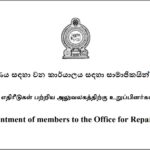By: Nalin Jayetileke
The International Day of Happiness is celebrated throughout the world on 20th March. The International Day of Happiness aims to make people around the world realize the importance of happiness in their lives. We have also heard and seen the topic being discussed regarding something called “the happiness index of a country,” where the Kingdom of Bhutan has been rated as the happiest country in the world. The world has seen many ways in which the said happiness index is taken on board as a concept and a system that has evolved, allowing one to determine how happy a country/state is, governed by certain accepted parameters. It is these parameters and quantitative/qualitative techniques that have been able to determine how happy a state can be.
Stemming out of the Biofach Organic food exhibition that was held in Nuremberg, Germany in February 2023, it was quite evident that when one talks about Organic food, there are clear distinctions and standards set in terms of accepting such an Organic product as a high-quality, healthy product. Many things are considered, such as the Certified Organic Origin of the Product, the quality certifications needed during the processing of such Organic products, and more importantly, the product needs to have a story behind it. The story helps the product gain good ground and acceptance within the Organic community. For example, if a product has a story that says it empowers women or differently-abled people and has a positive impact on the well-being of stakeholders at the grassroots level; it adds value and allows the product to penetrate the niche segment of the market.
There are many certification bodies and concepts that revolve around quality, especially when it comes to food items, be it Organic or non-Organic. Research has shown that there are many standards when it comes to food items, and if a product meets these standards, such as ISO, HACCP, Halal, JAS, GMP, to name a few, it carries its own value. In global markets, buyers check if such certifications or standards are in place, and if not available, they refrain from buying. Given the requirements of buyers, producing organizations are compelled to ensure these standards are met.
While researching the standards of quality in the field of food products, it was revealed that a product made by a group of happy people should hold more value than one produced haphazardly or without any willingness to produce. In a situation like this, the producer or line worker may not consider the benefits the product would bring or be happy about producing it. They might treat it as just a job or work under the directive of a manager. In fact, we need to understand why someone would consume something, and ultimately, it is for their happiness, health, or well-being that makes them happy. Arguing along these lines, it is strongly felt that any product made for consumption, if made by a group of happy people, should perform better than one that is haphazardly produced or made using an iron fist.
In my view, it is similar to a mother breastfeeding a child, where we understand that breastfeeding is the best form of milk, highly nutritious, healthy, and the cleanest and highest quality milk one could consume. When you ask why, the answers are very clear: it is because it is produced by the person who loves you the most and is given to you with lots of love, affection, passion, and willingness to eliminate the hunger of her child. This positive energy creates an essence that adds a whole lot of nutritional factors, making it the best milk in the world.
Giving due consideration to the fact of what it entails when a mother breastfeeds a child, my argument here for any product that is produced for consumption is the same. What I am saying is, if a product is produced happily, with a willingness to produce it, and the producers feel happy that they are doing it and happy working for the company that produces it, both physically and mentally, such products will have fewer or no quality issues. They would taste better and be more nutritional due to the positive vibes created during the production process. Consequently, such products create higher value. When you look at niche markets like the stakeholders in the field of organics, it is evident that they appreciate the trickling-down benefits. They understand what a company has done to keep its stakeholders, including their own staff, happy. This, in turn, results in products being pushed out with happiness for consumers to enjoy.
Nowadays, we have seen many international organizations setting standards and their parameters and concepts are well appreciated in Europe and all over the world. One such standard is referred to as a “living index” for an organization. This index assesses whether a person working in the company is paid a salary that allows them to manage themselves and set aside some money for any unexpected events from their monthly wages.
There are also international organizations that aim to change the way trade works by promoting better prices, decent working conditions, and a fairer deal for farmers and workers in developing countries. To confirm that a product has been obtained through a fair deal throughout the supply chain and during production, certification is done. A certificate is issued to indicate that the product is fairly traded, and many developed countries look for such certifications to ensure that all stakeholders, including the farmers, have benefited from producing it.
What is the Living Index?
The living index, also known as the cost-of-living index or general index, demonstrates the difference in living costs between cities. The cost of living in the base city is always expressed as 100, and the cost of living in the destination is then indexed against this number. The Consumer Price Index (CPI) or Cost of Living Index Number is used for this purpose.
For a significant portion of its existence, the Consumer Price Index (CPI) was based on the idea of comparing the costs of a fixed bundle or “basket” of goods. This concept led to what is referred to as a “basket price index” or “cost-of-goods index” (COGI). However, since the Stigler Commission report in 1961, there has been a growing emphasis on considering the CPI as a cost-of-living index (COLI).
There are strong arguments for replacing a pure cost-of-living index with a “conditional” cost-of-living index, which, in some respects, brings the COLI concept closer to a basket price index. As a result of this two-way traffic, significant differences in operating practices are uncommon. Most practical indexes or procedures for computing the CPI can be justified in terms of both approaches, although the arguments may vary.
One approach is the fixed-basket approach, where a basket of goods is priced in each period, and the price index is calculated by dividing the cost of the basket in the comparison period by the cost of the basket in the reference period. Since the goods in the basket remain fixed across the comparison, this is referred to as a “cost-of-goods index” or COGI.
Quality of life
Going by some of the research that has been carried out on this subject, the World Health Organization (WHO) has defined Quality of Life (QOL) as “an individual’s perception of their position in life in the context of the culture and value systems in which they live and in relation to their goals, expectations, standards, and concerns.” In this context, it is important to understand the standards that determine the quality of life. Accordingly, findings have revealed that it entails the following: wealth, employment, environment, physical and mental health, education, leisure time, recreation, social belonging, religious beliefs, safety, security, and freedom. QOL has a wide range of applications in the fields of international development, healthcare, politics, and employment. When we look at health-related QOL, it can be referred to as an evaluation of QOL and its relationship with health.
Fair trade:
A Living Income Reference Price indicates the price needed for a typical farmer household with a viable farm size and a sustainable productivity level to make a living income from the sales of their crop.
What are fair trade standards? Fair trade standards comprise both minimum social, economic, and environmental requirements that producers must meet to be certified, as well as progress requirements that encourage the continuous improvement of farmers’ organizations or the situation of estate workers.
This means trading with concern for the social, economic, and environmental well-being of marginalized small producers, and not maximizing profits at their expense. It involves conducting all trade in a fair and transparent way, as well as protecting cultural identity and traditional skills.
Living income:
Living income refers to having sufficient income to afford a balanced and decent standard of living for all members of a given household. This includes having access to a nutritious diet, clean water, acceptable quality housing, healthcare, education, and any other needs that can be considered essential for a person to live. It also requires having some extra resources for emergencies and savings, after deducting any fixed costs.
Computation of Organizational Happiness Index
Introduction:
Taking a clue from the Living Index and similar factors considered in what is called Fair Trade, I would like to introduce a system where we calculate the happiness of an organization, referred to as the “Organizational Happiness Index” or “O Hi” Index of a company.
How to Measure Happiness Index in an organization?
This can be done through a survey conducted within the organization and by engaging in constructive dialogues, which can be recorded. Different sectional heads can gather the views of their respective sections based on parameters set out by the company. Employee initiatives and innovations can also be taken into account. The company can implement feedback forms to rate happiness on a weekly basis, allowing us to gauge the employees’ level of happiness. Additionally, a customer feedback rating system can be implemented, where customers rate their satisfaction with the product. Lastly, an employee evaluation process can assess each person’s sense of belonging and attitude towards the company. While there can be more methods, these are of paramount importance in gauging employee happiness.
What are the happiness index indicators?
These indicators go hand in glove with how we recommend measuring employee happiness. The following are a few main domains: psychological well-being, health, education, time use, cultural diversity and resilience, good governance, community vitality, ecological diversity and resilience, and living standards.
What are the six factors of the Happiness Index?
The results tend to be predicted by six factors that contribute to whether people view their lives positively. These factors are GDP, social support, healthy life expectancy, freedom, generosity, and absence of corruption.
In determining the Organizational Happiness Index (O-Hi) Index of an Organization, it can be divided into four segments based on a simple point allocation system, where each category is rated out of 10 points:
- Somewhat happy: If the rating falls between 5-6.5 points- O-Hi ( Yellow)
- Happy: If the rating falls between 6.5-7.5 points- O-Hi ( Orange)
- Very happy and wants to make others happy too: If the rating is between 7.5-8 points- O-Hi ( Purple )
- Very happy with a high level of EQ (Emotional Quotient): If the rating is over 8 points.- O-Hi (Green)
If such an Organizational Happiness can be measured and recorded and given prominence by way of a symbol in any product, it can indicate to the consumer that the product they are consuming, especially food items, is produced with a sense of belonging, passion, love, and affection towards the work. As a result, such products have a greater probability of being of high quality and enhancing nutritional values, making them more beneficial for the human body.
A good testimony to support this notion is the recent achievement of a migrant Sri Lankan named Selvaraj, whose French bread was chosen as the best French bread made in France. When he was interviewed and asked what he believed made his bread taste better and stand out among other bread makers, Selvaraj said, “I make my bread with a lot of passion and always with a smile. I feel happy making it and want people to enjoy it, and that’s why my bread tastes the best.”
Based on such qualities, one can conclude that items produced with happiness can be sold at a premium price and are more valuable and suitable for consumption.
Sri Lanka could be the country to introduce a concept to international trade especially when it comes to food and any consumable products such as our Ceylon Tea which has a demand in the premium markets in the World. We as Sri Lankan’s could set a standard and start evaluating products and grant ratings after careful evaluation of the products. Such a rating displayed on a pack will make the consumer feel happy that he/she is consuming a product which is pure not only in terms of the process of production with no contamination, but is also associated with positive energy ensuring that the employees of the product themselves were happy by all expectations. This will eventually make the consumer feel good looking at the stakeholders who have been involved in the process of production.
Food for thought for Sri Lanka
“Copyrights reserved”
Reference credits/ Courtesy to:
Information courtesy: sources of information taken in Conceptualizing and doing the article https://nap.nationalacademies.org/
Reference:
National Academies of Sciences, Engineering, and Medicine. 2002.
At What Price?: Conceptualizing and Measuring Cost-of-Living and Price Indexes. Washington, DC: The National Academies Press.












